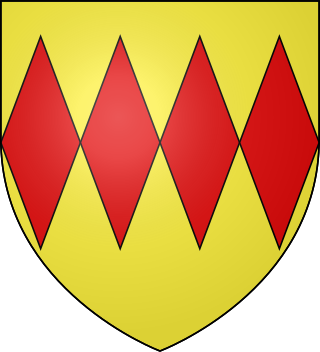Related Research Articles
John de Lindsay (Lindesay) or simply John Lindsay was a 14th-century bishop of Glasgow. He was from the Lindsay family, a family of Anglo-AxoNorman origin who had settled in Scotland, and in the 14th century were noted for their crusading exploits, a feature which earned them the patronage of the Scottish kings and who by the end of the century were elevated to comital status with the creation of the Earldom of Crawford. The Lindsay arms are depicted in Bishop John de Lindesay's seal. So also are the de Coucy arms, probably suggesting he had some sort of connection with this great French noble family. John was the son of Sir Philip de Lyndesay of the barony of Staplegorton, Philip was the son of John Lindsay of Wauchope, the 13th century Chamberlain of King Alexander III.
John Comyn (Cumyn) was Lord of Badenoch in Scotland. He was Justiciar of Galloway in 1258. He held lands in Nithsdale and Tynedale.

Clan Lindsay is a Scottish clan of the Scottish Lowlands.
Holders of the office of Lord Chamberlain of Scotland are known from about 1124. It was ranked by King Malcolm as the third great Officer of State, called Camerarius Domini Regis, and had a salary of £200 per annum allotted to him. He anciently collected the revenues of the Crown, at least before Scotland had a Treasurer, of which office there is no vestige until the restoration of King James I when he disbursed the money necessary for the maintenance of the King's Household.

David de Lindsay, Lord of Barnweill and Byres, was a Scottish knight and crusader. A minor baronial lord, he was the son of David de Lindsay and held lands in East Lothian and South Ayrshire. He became Justiciar of Lothian under Alexander II of Scotland in 1241. This position had been held by his father earlier in the century.

Alexander of Argyll, also known as Alexander of Lorne, and Alexander MacDougall, was a Scottish magnate from the late 13th and early 14th century.

John of Argyll, was a Scottish nobleman of the early 14th century. He is often known today as John Bacach, "the Lame", but there is no authority for that as a contemporary or near-contemporary nickname.
Alice Comyn, Countess of Buchan, Lady Beaumont was a Scottish noblewoman, a member of the powerful Comyn family which supported the Balliols, claimants to the disputed Scottish throne against their rivals, the Bruces. She was the niece of John Comyn, Earl of Buchan, to whom she was also heiress, and after his death the Earldom of Buchan was successfully claimed by her husband Henry de Beaumont, Earl of Buchan, by right of his wife. His long struggle to claim her Earldom of Buchan was one of the causes of the Second War of Scottish Independence.
Alexander de Abernethy was a Scottish baron. He was a son of Hugh de Abernethy and Maria de Ergadia. Alexander was a descendant of abbots of Abernethy; his great-grandfather Laurence, great-grandson of Gillemichael, Earl of Fife, was the first to style himself Lord (dominus) His daughter Margaret married John Stewart of Bonkyll, the new Scottish earl of Angus.
Philip de Valognes, Lord of Ringwood, Benvie and Panmure was an Anglo-Norman Scottish noble. He was the Lord Chamberlain of Scotland between 1165–1171 and 1193–1214.

Sir Henry de Baliol of Cavers was Chamberlain of Scotland.
Alexander Home, 2nd Lord Home was a Scottish nobleman and soldier, Lord Chamberlain of Scotland and Warden of the Eastern March.

Sir Alexander Lindsay, Lord of Barnweill, Byres and Crawford, also known as Alexander de Lindsay, was a Scottish noble.

Sir David Lindsay of Crawford was a Scottish noble.

Sir John de Soules was Guardian of Scotland from 1301 to 1304 in the Wars of Scottish Independence. He was a member of the de Soules family.
Reginald de Mure, Lord of Cowdams, Cameskan and Abercorn was a Scottish noble. He was the Lord Chamberlain of Scotland between 1329 and 1333 and between 1334 and 1340.
Walter de Lindsay, Lord of Lamberton and Molesworth, Fordington and Ulceby, Justiciar of Lothian, Sheriff of Berwick was a Scottish noble, who held lands in Scotland and England.
Nicholas de Soules, Lord of Liddesdale and Butler of Scotland, was a 13th-century Scottish Border noble.

Henry de Pinkeney, Lord of Weden-Pinkeney, Fulmer and Datchet in England and Lord of Crawford in Scotland, was a 13th-century English noble.

Sir James (de) Lindsay, 9th Lord of Crawford, Knight Banneret, Lord of Crawford, Kirkmichael, Wigton, Symontoun, and of many other baronies, claiming also to be Lord of Buchan, was a Scottish feudal lord.
References
- McAndrew, Bruce A. (2006). Scotland's Historic Heraldry. Boydell Press. ISBN 9781843832614.